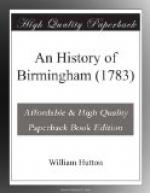Upon the borders of the parish stands Aston-furnace, appropriated for melting ironstone, and reducing it into pigs: this has the appearance of great antiquity. From the melted ore, in this subterranean region of infernal aspect, is produced a calx, or cinder, of which there is an enormous mountain. From an attentive survey, the observer would suppose so prodigious a heap could not accumulate in one hundred generations; however, it shows no perceptible addition in the age of man.
There is also a common of vast extent, called Wednesbury-old-field, in which are the vestiges of many hundreds of coal-pits, long in disuse, which the curious antiquarian would deem as long in sinking, as the mountain of cinders in rising.
The minute sprig of Birmingham, no doubt first took root in this black soil, which, in a succession of ages, hath grown to its present opulence. At what time this prosperous plant was set, is very uncertain; perhaps as long before the days of Caesar as it is since. Thus the mines of Wednesbury empty their riches into the lap of Birmingham, and thus she draws nurture from the bowels of the earth.
The chief, if not the only manufactory of Birmingham, from its first existence to the restoration of Charles the Second, was in iron: of this was produced instruments of war and of husbandry, furniture for the kitchen, and tools for the whole system of carpentry.
The places where our athletic ancestors performed these curious productions of art, were in the shops fronting the street: some small remains of this very ancient custom are yet visible, chiefly in Digbeth, where about a dozen shops still exhibit the original music of anvil and hammer.
As there is the highest probability that Birmingham produced her manufactures long before the landing of Caesar, it would give pleasure to the curious enquirer, could he be informed of her size in those very early ages; but this information is for ever hid from the historian, and the reader. Perhaps there never was a period in which she saw a decline, but that her progress has been certain, though slow, during the long space of two or three thousand years before Charles the Second.
The very roads that proceed from Birmingham, are also additional indications of her great antiquity and commercial influence.
Where any of these roads lead up an eminence, they were worn by the long practice of ages into deep holloways, some of them twelve or fourteen yards below the surface of the banks, with which they were once even, and so narrow as to admit only one passenger.
Though modern industry, assisted by various turnpike acts, has widened the upper part and filled up the lower, yet they were all visible in the days of our fathers, and are traceable even in ours. Some of these, no doubt, were formed by the spade, to soften the fatigue of climbing the hill, but many were owing to the pure efforts of time, the horse, and the showers. As inland trade was small, prior to the fifteenth century, the use of the wagon, that great destroyer of the road, was but little known. The horse was the chief conveyor of burthen among the Britons, and for centuries after: if we, therefore, consider the great length of time it would take for the rains to form these deep ravages, we must place the origin of Birmingham, at a very early date.




